Skype: neodalle-travel
Tel: +86 135 7447 2266
E-mail: sales@zhangjiajieholiday.com
What to see?
Danxia Mountain Scenic Area contains more than 680 various stone peaks, stone fortresses, walls, pillars and stone bridges. The stones have been formed over the eons by nature, many of which take the shape of the human body, birds and even animals. The numerous stones and peaks are rhythmically interspersed among the scenic spot, making it a sculpture garden of red sandstone rocks. Set against the blue sky, white clouds, jade waters, green trees and the colorful algae, the mountain becomes a picturesque painting.
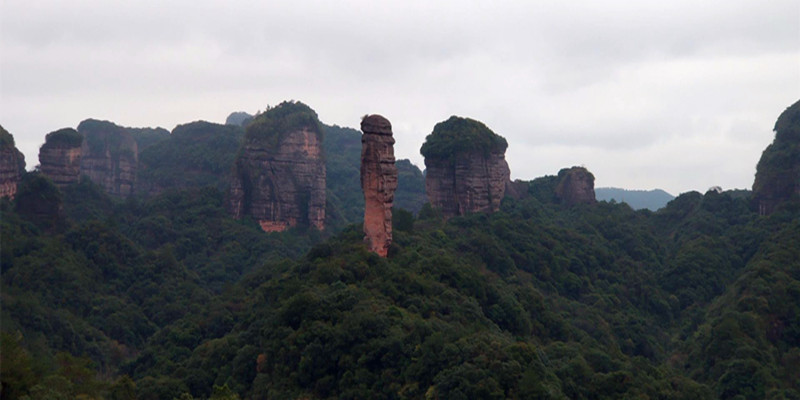
The enchanting mountain has a rich variety of plants due to the moderate subtropical climate and the yearly monsoons that provide plenty of rainfall. There are twenty-eight ancient trees over one hundred years old, with fourteen of them having survived for more than three centuries. These ancient Danxia Phoenix Trees are native to this area and are the most distinguished species of the mountain. Of the ten varieties, four of them are extremely rare. One such variety of the Phoenix Trees has been named the 'Dharma Orchid'. It was discovered in 1987, and only two of them have existed in the world. When flowering season arrives, the sweet scent of the orchid tree lingers in the mountain and visitors swarm to its attraction.
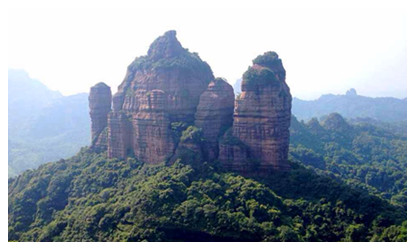 |
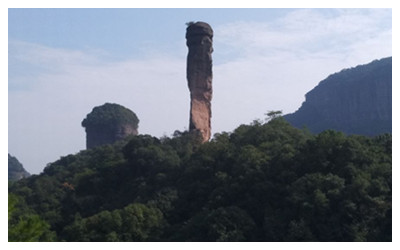 |
The Danxia Mountain consists of many other wonderful scenic spots, including Zhanglao Peak, Yangyuan Hill, Xianglong Lake and Jin River. At the foot of Zhanglao Peak, there is a grotto temple that was built during the Northern Song Dynasty (960-1127). Yangyuan Hill and Zhanglao Peak face each other across a river.
Yangyuan Hill
Yangyuan Hill, meaning “The Hill of Male Sex', is so named because the stone column here,28 meters tall and 7 meters in diameter, is the very image of man’s external genitals. According to geological studies, this stone column was a part of the cliff and is is over three hundred thousand years since Mother Nature severed it from the mountain body and carved it into this shape. In the old days, men were regarded as superior to women and people often prayed for having more sons to carry on their family name; therefore this stone column was highly worshiped by the pilgrims.The hill is renowned for the marvelous Yangyuan Stone, which looks like a male genital.
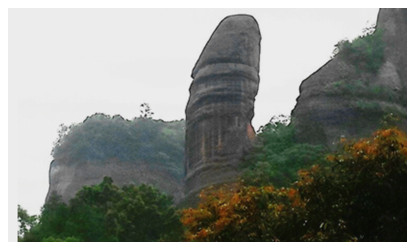 |
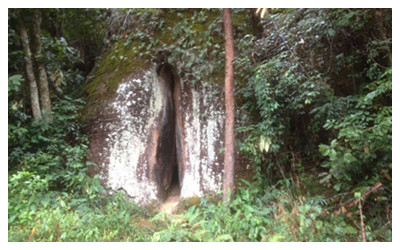 |
| Yangyuan Hill | Yinyuan cliff |
Yinyuan cliff
This steep face of rock is called Yinyuan Cliff, meaning Stone Cliff of Female Sex in English, because it is a strong resemblance of woman’s external genitals. It was formed some one hundred thousand years ago. Just as God had sculptured the first man and his wife, Adam and Eve, in the Garden of Eden, so had Nature carved a couple of stone husband and wife in the Danxia Mountain. What a wonderful world this is!
Xianglong Lake (Flying Dragon Lake)
Lying to the south of Zhanglao Peak, named so because the lake resembles a flying dragon. The Jin River features charming waterside scenery and wonderful aquatic programs, such as swimming, boating and yachting.
Countless cliff tombs and cliff coffins of times long ago were left by our ancestors who inhabited the mountain. In addition, the mountain has been a busy place for Buddhism activities since the Sui (581-618) and Tang Dynasties (618-907). In the Ming and Qing Dynasties, the mountain prospered and more than eighty temples were built. A great number of poems, carvings and inscriptions praising the bewitching scenery were left behind by writers, poets and painters throughout past dynasties.
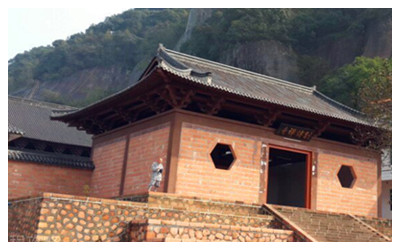 |
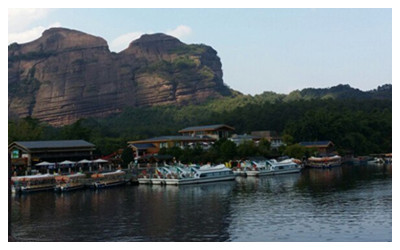 |
| Biezhuan Temple | Flying Dragon Lake |
Biechuan Temple
The Biezhuan Temple, which lies in the middle of the Zhanglao Peak, is one of the ten most notable temples of Guangdong.Built in 1662, i.e. The first year in the reign of Emperor Kangxi of the Qing Dynasty, it was frequented by a large number of pilgrims and is one of the three largest Buddhist monasterires in Northern Guangdong ( the other two being the Famen Temple in Ruyuan county and the Nanhua Temple in Qujiang County). Up on the main gate of the temple, there are four Chinese characters: Bie Chuan si , meaning Biechuan Chan Buddhist Monastery. They were written by Li Hanhun, who was then chairman of the Guangdong provincial Government of the RPC. Going through the gate, we can see many engravings on the red cliff. Among them the two big Chinese characters Dan Xia, 5-6 square feet each, are the most beautiful. They were written by an official of the Qing Dynasty.
The Biechuan Temple is constructed in more or less the same layout as other Buddhist monasteries . It consists of the Hall of the Heavenly kings, the bell and drum towers, the sakyamuni Hall and the Hall of the Goddess of Mercy and so on. Now you can look around on your own for a while. We’ll meet half an hour later at the entrance and will go down-hill, by the same way as where we came up, to the pier to take a boat-ride on the Jinjiang River so that you may feast your eyes on the beautiful scenery along the river.
Travel Tips
Add: Renhua County, Shaoguan City, Northern part of Guangdong Province
Opening Hours: 08:00-18:00
http://www.tourdxs.com/
Entrance Fee:
CNY 200 (including Crouching Tiger Hillock and Danxia Mountain)
CNY 60 for Bazhai village.
CNY 90 for Jin River Cruise.
CNY 100 for bamboo raft drift
Xianglong Lake pleasure boat: CNY 35 for a round trip, CNY 20 for a single trip.
Round trip cable Car: CNY 60 during the weekdays, CNY 70 during the holidays.
Single trip cable car: CNY 40 during the weekdays, CNY 45 duri
 Ask Questions ?
Ask Questions ?